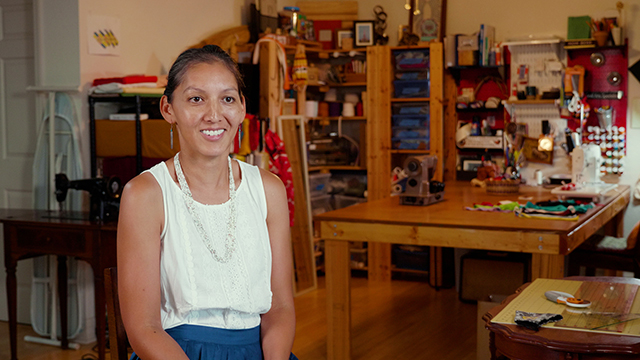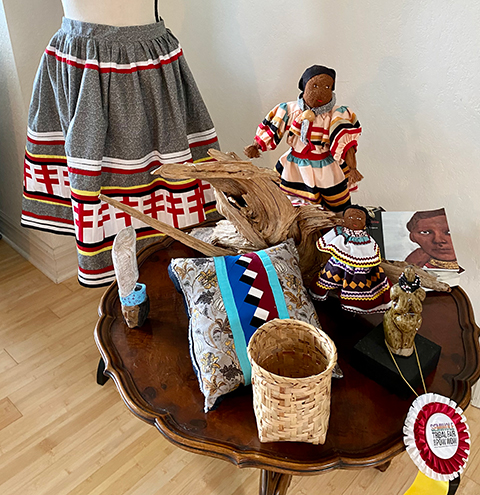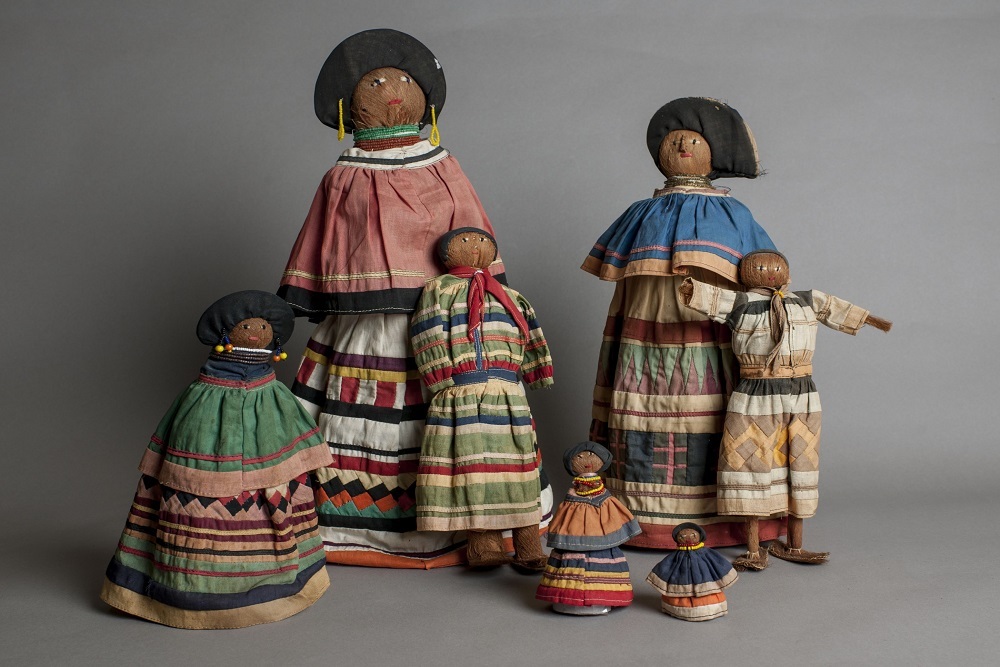Florida Gulf Coast University issued the following announcement on October 11.
Head bowed over a humming sewing machine, Jessica Osceola stitches together white and red fabric strips that will become part of a decorative motif on a handmade skirt. This patchwork threads together not just cloth, but in a larger sense the past and the present, tradition and change, and two cultures enmeshed in the fabric of her identity.
Patchwork is a signature textile design developed by Seminole women, Osceola’s Native American ancestors, and passed down to the FGCU alumna and adjunct art instructor by her great-grandmothers and grandmothers. Growing up in a Seminole village off the Tamiami Trail near Naples, Osceola watched and worked alongside these matriarchs, absorbing their ways with material, colors and shapes. She learned beadwork, woodcarving, basket-weaving and other arts entwined with the tribe’s culture, sense of community and livelihood.

Growing up in a Seminole village near Naples, FGCU alumna and adjunct instructor Jessica Osceola watched and worked alongside her grandmothers, absorbing their ways with material, colors and shapes.
That heritage echoes in Osceola’s art and around her home studio. An antique Singer sewing machine attached to a wooden table belonged to one of her grandmothers, Tahama Osceola, who died last year. On another table displaying Seminole dolls, textiles and a saw palmetto basket she made, sits a wood carving she fashioned of Osceola, the famous tribal warrior who fought against the forced relocation of Florida’s Indigenous people in the Seminole Wars.
“There are roughly 5,000 members in the Seminole tribe today. When you narrow it down to seamstresses or crafters making dolls, there are only a handful of people,” Osceola says. “I feel a tremendous responsibility to continue that legacy, especially with my children.”
Her textiles and bas-relief ceramic self-portraits recently spotlighted that legacy in a solo show at the Marco Island Historical Museum. Her fabric work also will be part of an exhibit featuring Seminole artists at History Fort Lauderdale that opens in November, which is Native American Heritage Month. Celebrations like that, and Indigenous Peoples Day on the second Monday of October, help raise awareness and appreciation of the history, unique culture and enduring traditions of Native Americans.
“These days are important — they bring attention to things people think are in the past,” says Osceola, 36. “People always think Indigenous cultures are of the past. There needs to be attention to the crafts and traditions that continue to go on. They’re not relics of the past … dusted off from a museum shelf.”
The white and blue skirt she wears today, for instance, represents Seminole tradition with intricate patchwork; the zigzagging rickrack trim adds a modern twist, she says. A gift her father bought her at a tribal fair, it’s a dressier version of the type of three-quarter-length Seminole skirt that might be worn for everyday activities like going to a market.
This time-spanning theme is also explored in Osceola’s latest work in textile art, including Seminole skirts and aprons as well as menswear like a medicine man’s jacket. Her turn toward textiles in recent years partly reflects a maternal urge to strengthen the line from past to present to future.

A selection of Jessica Osceola’s work.
“When you have children, you think more about your identity, where you’re from, where you’re going — all those things that are important to give to your children.”
And so, she teaches 7-year-old Juaquin woodcarving and basketmaking. Someday, she’ll do the same with his brother, McCoy, whom she and her husband, Benjamin Velasco, welcomed about 6 months ago. They will grow up, as she did, balancing their Seminole heritage with their mainstream education, and maintaining a connection to the land. The growing family resides along with free-range chickens and other livestock on a 10-acre farm about a half-hour southeast of FGCU where they practice sustainability as much as they can. They share eggs with family and friends, bake bread, can vegetables and make new paper from recyclables.
Becoming a mother rekindled a fire in Osceola to pass the legacy of her ancestors along to a new generation. But she has long contributed her time and teaching abilities within the Seminole community – even while pursuing her 2008 FGCU art degree and her 2016 MFA from the Academy of Art University in San Francisco. Higher education is not a typical path among the Seminole, she says; but it’s another way that she models the weaving together of traditional and modern life. Adding to the tapestry of identity is the Irish-American background of her mother, who moved to her father’s village after they married. Osceola’s husband is from Chile, so their children add another cultural line to the braid.
“I’m always balancing,” Osceola says. “I was immersed in Seminole culture even though I had American schooling. There are a lot of experiences I don’t think are mainstream that shaped me. Multiple families lived in the Seminole village I grew up in, so there were always people working and lots of kids running around. My dad would be hanging and skinning a deer in the yard for the meat. My uncle I remember shaving cypress logs to build chickee huts. There were chickees for cooking, chickees for eating, chickees for hanging out.”

In her life and work, Jessica Osceola balances her Seminole heritage with her mother’s Irish-American background.
The aroma of food cooking over an open fire. The constant clacking of her grandmothers’ sewing machines. Osceola conjures up the sensory memories of the place where her artistic sensibilities bubbled up even before she learned to string beads to be sold at fairs and gift shops. Rocks, leaves, glue, tape — whatever she could get her crafty little hands on – came together in childhood sculptural forays. Growing up, she learned not only the techniques for handcrafting items but respect for the materials and their origins.
“You have to learn about nature and how to harvest the materials,” Osceola says. “Where does sweetgrass grow? How does the saw palmetto need to be treated? There’s an education of the actual art (of making a basket) and then there’s the natural education of it that goes hand in hand. You have to learn from start to finish to get to that basket.”
By the time she was studying at FGCU, Osceola realized art could be a platform to creatively express her journey with her dual identity as well as her thoughts on themes like commercial appropriation of Indigenous culture.
As she states on her website: “The focus of my art is to convey the inner and outer conflict experienced by a biracial female trying to find her place in society.”
“People are more accepting of multicultural children (now),” Osceola says, recalling how some people in public reacted to seeing her alongside her white mother. “When I grew up, it was ‘Is that your nanny?’ ‘Why are you so dark?’ People were always pointing those things out to me. To me, she was just mom. For other people, we were two different-colored people.”
Seminole. Irish-American. Wife and mother. Artist. Teacher. Farmer. There are many more than two sides to the identity Osceola explores in life and art. The point is: She gets to decide who she is, not the people who only see “different-colored” skin.
“Whichever direction I’m going in — into the classroom as a professor at FGCU or in a classroom outdoors teaching kids how to harvest sweetgrass — there’s always the responsibility to be the best of yourself and what you’ve acquired through traditional or Western education,” Osceola says. “You just try to elevate it.”
Original source can be found here.

 Alerts Sign-up
Alerts Sign-up